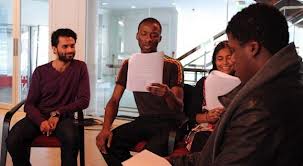

Why Dramatic Writing and Reading?
Playwriting can be a useful tool in active learning, especially if you take the stance that plays are meant to be heard and seen and not simply read silently by individuals. Just about any subject can be enriched by the addition of a dramatic writing and reading aloud activity. Historical meetings can be interpreted by writers, issues such as bullying, stereotyping and diversity can be addressed and relationships can be explored. Tragedy, satire, parody, docudrama and other genres and styles can be utilized by students who have the opportunity to offer their vision, ideas and questions about a specific topic, theme or issue. A short scene written by 15 individual students on a topic such as diversity and friendship should yield 15 unique plays with various situations, characters, conflicts and resolutions. And that can engender a lot of fantastic discussion.
Need Training?
One problem for many classroom teachers is they don’t have the training to teach playwriting or to create dynamic staged readings. They may not understand play formatting, how to activate dialogue or the manner in which characters can be created. After the plays are written comes the challenge of generating readings, either sit-down or staged script-in-hand performances. Teachers I’ve spoken to who don’t have theatre or playwriting experience are often intimidated by the idea. The truth is you don’t need an M.F.A. in playwriting to use it in your classroom. But some insight, guidance and experience can help.
Ways to Get Training
Here’s a quick list on how teachers can get some fast training in playwriting and reading. One of these may work for you.

1) Take an online class in playwriting.
2) Ask your school’s drama teacher or play director for help.
3) Ask a LA teacher for help. (They may have experience.)
4) Ask the dramatic writing instructor at a local university to do a workshop for you and your colleagues. (They may do it for free as part of their community service. I know I’d give three hours of my time towards this.)
5) Join a playwriting/reading group in your community. (There may be one.)
6) Utilize online resources such as Broadway Educators. (We have some playwriting exercises online now and will have more helpful material online in the near future.)
7) If you have a professional theatre nearby check with them. They may offer courses or have some sort of community outreach that you can utilize.
What you need is instruction on some basics such as:
1) Creating character and dialogue
2) Play/scene structure
3) Physical and dramatic action in plays
4) Time, Place, Character Descriptions, Setting
5) Importance of the play title
6) Formatting
7) How to use stage directions
8) Basic playwriting exercises
Writing, Reviewing, Rewriting, Reviewing
The idea is to have students write short plays ranging in length from 3 to 5 pages. (There are about 14 lines of dialogue on a properly formatted page. This does vary depending upon the use of stage directions, the utilization of monologues, etc.) The point is that these are not long pieces but they can be effective. (Here is an example of a good first playwriting exercise.)
It’s important that once a scene is written that it’s reviewed by you for clarity and appropriateness. This gives you the chance to offer suggestions to the writer and for them to do some rewriting. Once the rewrite, if necessary, is done another quick review is in order. Once that’s done, you can start to set up the reading.
Reading Aloud Tips Next
In my next blog, I’ll address the second and third major steps in this process- the reading aloud of the new scripts and their discussion. These second two steps involve some important skills, including collaboration, interpretive reading and literary analysis. They are essential because they are what make this process and learning active, immediate and exciting.
Exercise Contributed by Paul Mroczka
Paul is Director of Educational Resources for BroadwayEducators.com and is faculty emeritus at Plymouth State University, Plymouth, NH.

 Random Item
Random Item